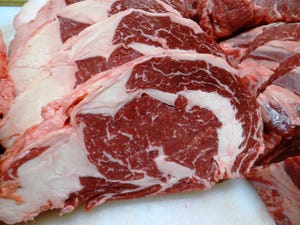Ranchers bring local beef to schools
Despite strict requirements for the nation’s school lunch program, area ranchers have found ways to get locally-raised beef into South Dakota schools.
February 4, 2019

It’s been nearly 15 years since I’ve eaten a school lunch in my high school cafeteria, but I still remember the burgers. Thin, dry and bland — they were hardly an advertisement for beef.
As a beef producer myself, I remember thinking, “We could do better.”
And now that the Trump Administration is giving more state flexibility to tailor school lunch programs to better fit the needs of students, perhaps we can and should do better as a beef industry.
In my home state of South Dakota, there are a few success stories about ranchers who have been able to bring locally-raised beef to the students in their districts. Here are two examples of South Dakota schools that are now enjoying beef raised by ranchers in the area.
Wall made South Dakota history as the first school to bring local beef to its lunch program.
According to an article published in KOTA Territory News, “The Wall School District is trying out a new school lunch program, where local ranchers are serving up their beef for the students. After finding out about the lunch program starting in Nebraska, a rancher brought the idea to the Wall School District to try in South Dakota.
“‘Not very many people have anything to do on a day-to-day basis with farming and ranching. It's important for us in agriculture to share our message and engage with the public and what a better age than elementary, middle school and high school students,’ says Josh Giegle, a rancher in Wall.
“’Local beef is not only nutritious for these students, but it also gives them a moment to learn about where their food comes from and the ranchers involved.
“‘Some of them don't, maybe don't even realize where beef comes from in the first place. And now when they found out it's their dad, their uncle, a family member, it's actually someone from their ranch, I think that's a really neat thing,’ says Wall School District Superintendent Dan Baldwin.”
In Burke, South Dakota rancher Sara Grim worked tirelessly to jump through hoops to get beef in the local school.
According to an article published in the Mitchell Daily Republic, “Grim said she had noticed states like Nebraska and North Dakota were able to get local programs going. In Nebraska, for example, 50 school districts are part of a program to bring local beef into school lunches through the state's department of agriculture.
“‘We just ran into a lot of brick walls,’ said Grim, who was frustrated by news that kids were going home from school hungry because of changes to the school lunch program made on the federal level.
“But the right connections were made, and the help of Burke Superintendent Erik Person put the donation of three cows to the school district into action. Earlier this month, they held a hamburger feed for lunch to celebrate the kickoff of the program. It was the third time Burke students had eaten local beef that week, after main entrees of tacos and beef stroganoff.
“‘You have to have that push there,’ said Person. ‘Just coming from the school, I don't know how well it would have worked. I never asked anyone to donate any beef. I didn't have to. We have a better product now.’”
This may be difficult to duplicate at other schools, as most are under contract to purchase commodity beef from the National School Lunch Program, which is overseen by the USDA. However, as USDA Secretary Sonny Perdue eased some of the lunch program requirements in 2018, I see a window of opportunity for local ranchers to connect with their region’s school districts.
A partnership of this ilk doesn’t just provide high-quality beef to the students, but it also allows young people to make connections with the people who produce beef on their ranches. It’s a win-win scenario that I hope can be further duplicated across the country.
The opinions of Amanda Radke are not necessarily those of beefmagazine.com or Farm Progress.
About the Author(s)
You May Also Like





